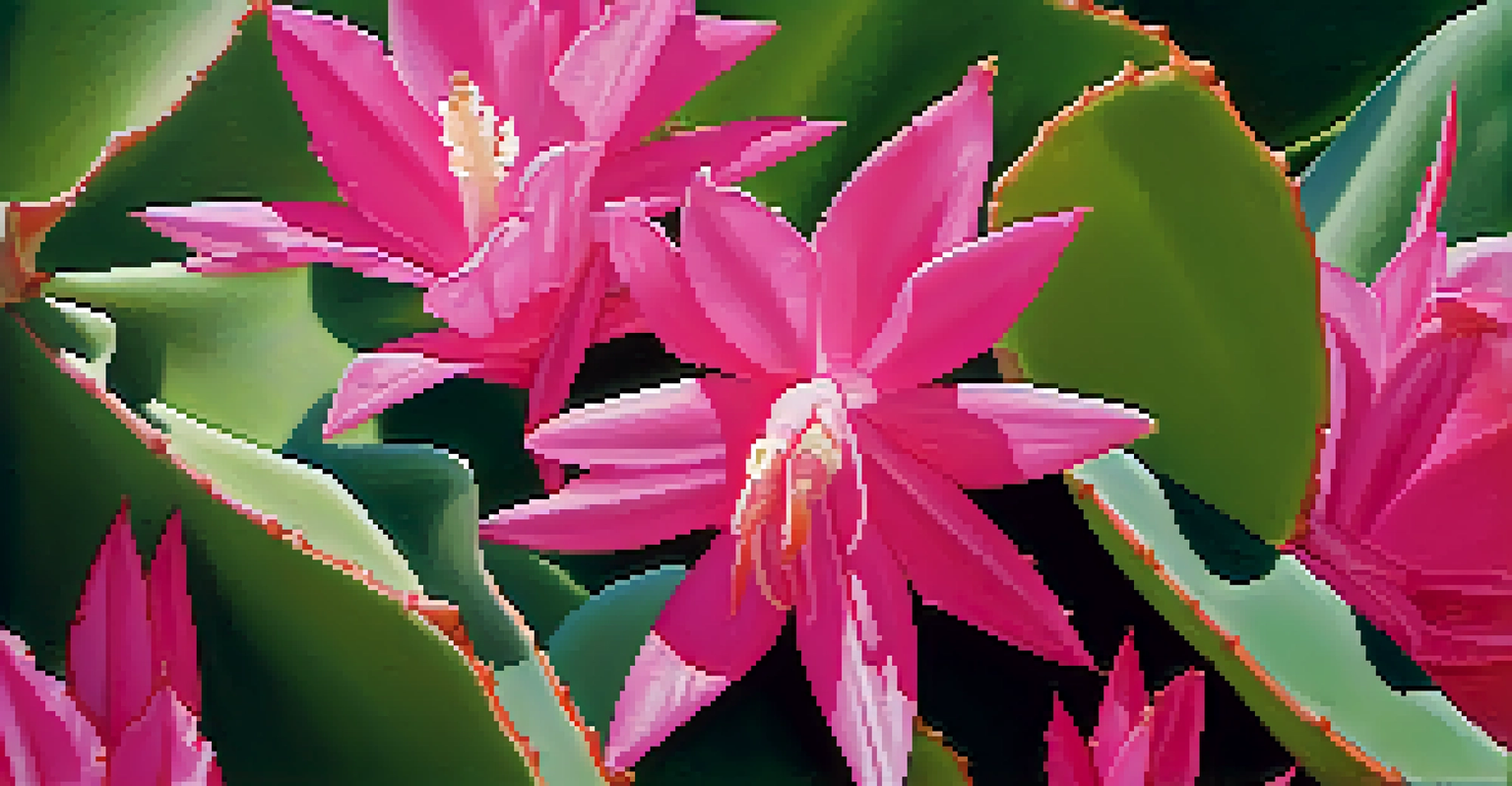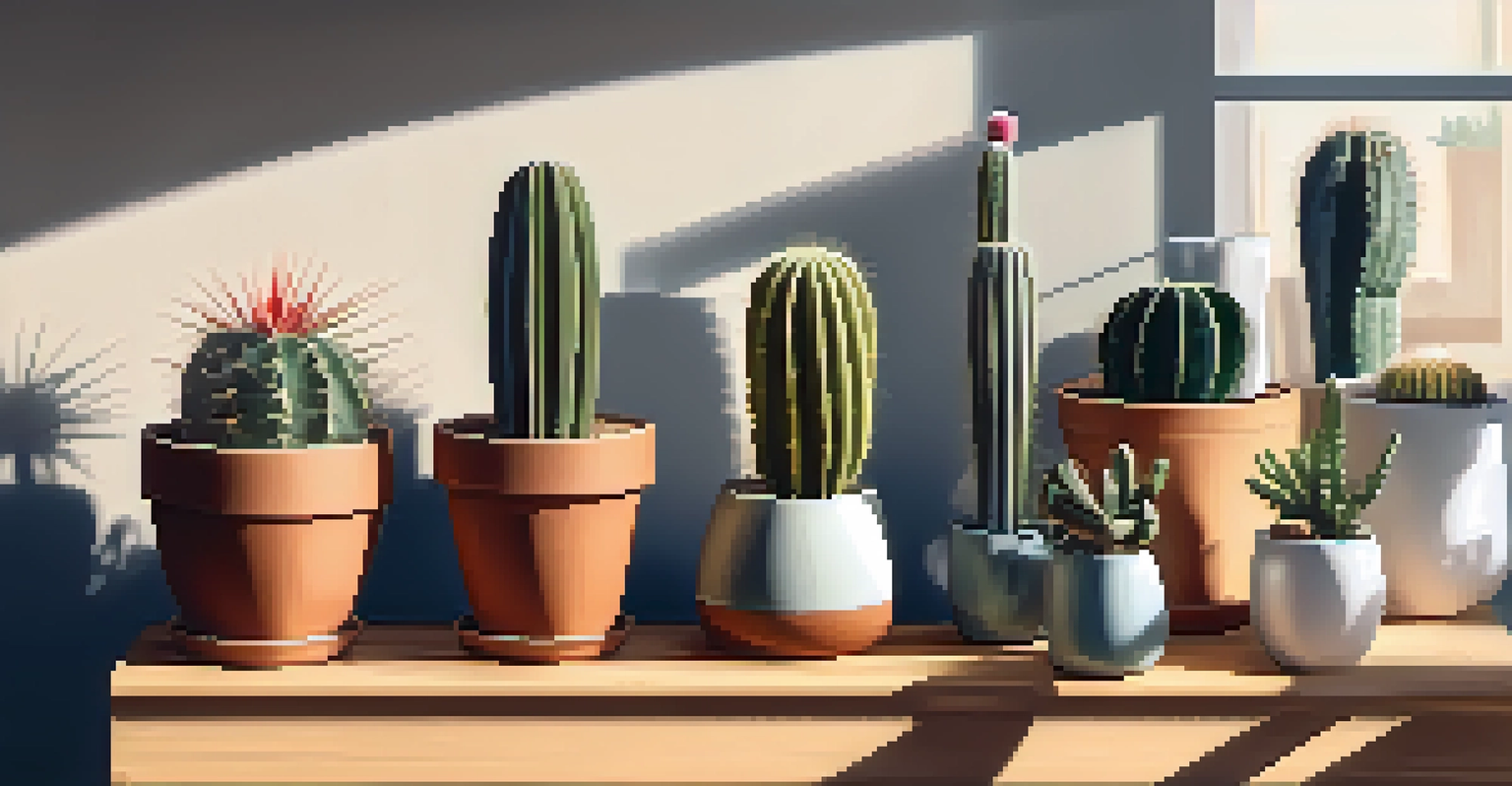Essential Guide to Cacti: Types, Characteristics, and Care

Understanding Cacti: An Overview of Their Unique Traits
Cacti are fascinating plants that thrive in arid environments, showcasing remarkable adaptations. Their thick, fleshy stems store water, allowing them to survive long periods of drought. Additionally, many cacti are equipped with spines, which serve not only as a defense mechanism against herbivores but also help reduce water loss by creating shade.
Cacti are like little soldiers, standing tall and resilient in the harshest conditions.
One of the most intriguing characteristics of cacti is their ability to photosynthesize differently than most plants. Instead of the standard method, cacti often utilize a process called CAM (Crassulacean Acid Metabolism), which means they open their stomata at night to minimize water loss. This unique adaptation is a key reason why cacti can flourish in harsh climates.
With over 2,000 species worldwide, cacti come in various shapes, sizes, and colors. Some are small and round, while others can grow towering and tall. This diversity makes them not only resilient but also a popular choice for both indoor and outdoor gardening.
Diverse Types of Cacti: A Closer Look at Popular Varieties
When it comes to cacti, the variety can be overwhelming. Some popular types include the iconic Saguaro, known for its tall, tree-like structure and beautiful flowers, and the Barrel cactus, which is easily recognized by its round shape. Each type has its own unique characteristics and care requirements, making it essential to choose wisely based on your environment.

The Christmas Cactus is another favorite, particularly during the holiday season. Unlike many cacti, it prefers a bit more humidity and less direct sunlight. This adaptability makes it a great option for indoor settings, and its vibrant blooms can bring a splash of color to your home.
Unique Traits of Cacti
Cacti have remarkable adaptations, such as water-storing stems and a unique photosynthesis process, allowing them to thrive in arid environments.
For those who love a challenge, the Opuntia, or Prickly Pear cactus, is intriguing. With its flat pads and edible fruit, it offers both aesthetic appeal and culinary potential. However, this variety does require careful handling due to its sharp spines.
Cacti Characteristics: Key Features That Define Them
Cacti are defined by several key features that set them apart from other plants. One of the most notable is their thick, waxy skin, which helps prevent moisture loss. This feature is crucial for survival in their native desert habitats, where water is scarce.
The desert is a beautiful place, and cacti are its vibrant jewels.
Another important characteristic is their growth patterns. Many cacti grow slowly, sometimes taking years to reach maturity. This slow growth means that they often require minimal maintenance once established, making them ideal for busy plant enthusiasts.
Additionally, cacti often bloom with stunning flowers that can be quite striking against their spiny exteriors. These blooms can vary in color and size, attracting pollinators like bees and hummingbirds, further enhancing their role in the ecosystem.
Essential Care Tips for Thriving Cacti at Home
Caring for cacti may seem straightforward, but there are key tips to ensure they thrive. First and foremost, it's vital to provide the right amount of sunlight. Most cacti prefer bright, indirect light, so placing them near a window is usually ideal. However, too much direct sunlight can scorch their delicate skin.
Another crucial aspect of care is watering. Cacti require infrequent watering, typically every few weeks during the growing season, and even less during dormancy. A good rule of thumb is to let the soil dry out completely between waterings, as overwatering is one of the most common causes of cactus decline.
Popular Cactus Varieties
With over 2,000 species, cacti come in various shapes and sizes, each with specific care requirements, making them suitable for different environments.
Lastly, consider the type of soil you use. Cacti thrive in well-draining soil, often mixed with sand or perlite to promote drainage. This helps prevent root rot and ensures that your cactus remains healthy and vibrant.
Common Cactus Problems: Identifying and Solving Issues
Despite their hardy nature, cacti can face a few common problems that may affect their health. One frequent issue is root rot, often caused by overwatering. If you notice your cactus becoming mushy or discolored, it may be time to reassess your watering schedule and check for drainage issues.
Pests like mealybugs and spider mites can also pose a threat to your cactus. These tiny invaders can cause significant damage if left unchecked. Regularly inspecting your plants and using insecticidal soap or neem oil can help keep these pests at bay.
Additionally, if your cactus is stretching or leaning towards the light, it might not be receiving enough sunlight. To remedy this, simply rotate your cactus or move it to a brighter location to encourage even growth.
Propagation Techniques: Growing New Cacti from Cuttings
Propagating cacti can be a rewarding experience, allowing you to expand your collection or share with friends. The most common method is through cuttings, where you take a healthy segment of a cactus and allow it to callous over before planting it in soil. This process helps prevent rot and encourages new growth.
Another popular method is from seeds, which can be a bit more time-consuming but also fun. Start by planting seeds in a well-draining mix and provide warmth and humidity to encourage germination. With patience and care, you'll soon see little cacti sprouting up!
Essential Cactus Care Tips
Proper sunlight, infrequent watering, and well-draining soil are crucial for maintaining healthy cacti at home.
Regardless of the method, remember that patience is key. Cacti take time to establish and grow, so don’t get discouraged if you don’t see immediate results. With consistent care, your new cacti will flourish in no time.
Creating a Cactus Garden: Design Ideas and Inspiration
Designing a cactus garden can be a creative and fulfilling project. Start by selecting a suitable location with ample sunlight and well-draining soil. You can create a desert-inspired landscape with varying heights and colors by mixing different cactus varieties.
Consider incorporating decorative elements like rocks or gravel to enhance the arid theme, and don't forget to add some drought-resistant companion plants for visual interest. This combination not only adds depth but can also provide a natural habitat for beneficial insects.

Lastly, think about the maintenance aspect. Grouping cacti with similar care requirements can make watering and grooming easier. With a little planning and creativity, you can create a stunning cactus garden that showcases these resilient plants beautifully.